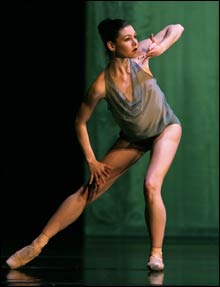 Helen Pickett’s Etesian, which opened Boston Ballet’s “Grand Slam” program of contemporary works last Thursday, began with a lone dancer (Kathleen Breen Combes) adrift on a sea of darkness. Two filmy panels were hung from above the immense stage, and pianist Freda Locker in the pit began to play Bach’s Goldberg Variations. A man appeared far away upstage. Hard to tell who he was and whether he’d been there all along, gradually emerging in Karim Badwan’s moody lighting. He was very still and watchful as Breen Combes stretched out and collapsed, jutting and twisting as her whole body obeyed one wayward surface or segment.
Helen Pickett’s Etesian, which opened Boston Ballet’s “Grand Slam” program of contemporary works last Thursday, began with a lone dancer (Kathleen Breen Combes) adrift on a sea of darkness. Two filmy panels were hung from above the immense stage, and pianist Freda Locker in the pit began to play Bach’s Goldberg Variations. A man appeared far away upstage. Hard to tell who he was and whether he’d been there all along, gradually emerging in Karim Badwan’s moody lighting. He was very still and watchful as Breen Combes stretched out and collapsed, jutting and twisting as her whole body obeyed one wayward surface or segment.
The mood was austere, even desolate. But there was something interesting about the way the two dancers paid attention to each other and disregarded the mysterious situation in which they found themselves.
Helen Pickett was an unknown choreographic quantity to me, except that she’d danced with William Forsythe, and the opening of Etesian had that air of suppressed hysteria you often find in his dances. As it went on, though, it seemed to get more relaxed, or maybe I did. Dancers came and went in clusters, like pedestrians, meeting unexpectedly, pausing to consider points in a conversation, moving on.
Certain ballet moves began to get more noticeable. You felt their assurance that the body could return to familiar phrases and alignments after the most extreme distortions. The women spun on pointe. The men made wide circling leg gestures and traveling leaps.
Their gatherings took on moments of formal unison. They could become an ensemble, not just any individuals. Four women collected into a square in one part of the space and four men in another. Their movement was more legible but just as odd. Romi Beppu did a strange solo, her legs and arms splayed out one minute, wrapped close in the next, and whirling through space on pointe.
The whole group staged another formal passage — mixed-gender quartets mirroring each other. In a solo, Yury Yanowsky seemed pulled toward the floor even as he jumped and tilted away from it.
The music had traveled through more Bach and some Beethoven. Beppu started another solo behind one of the panels, which was now lit with a blue spill. Beethoven stopped abruptly. She kept dancing. The curtain came down.
This kind of work suits these dancers very well. Without the need to create illusion or character, Pickett’s cryptic choreography added the power of suggestiveness to their physicality. The opening-night cast was completed by Rie Ichikawa, Heather Myers, Mindaugas Bauzys, John Lam, and James Whiteside. According to the program notes, in certain parts of the ballet they could choose what to perform from units of material they’d learned. This wasn’t evident in the dance, but a latent theatricality was.
After Etesian the program got less and less surprising. Jorma Elo’s over-the-top Plan to B (2004) came out of a similar European æsthetic — movement for its own sake. But where Pickett’s dance was spare and drawn to classical order, Elo’s came across as decorative, programmed for splashy effects.